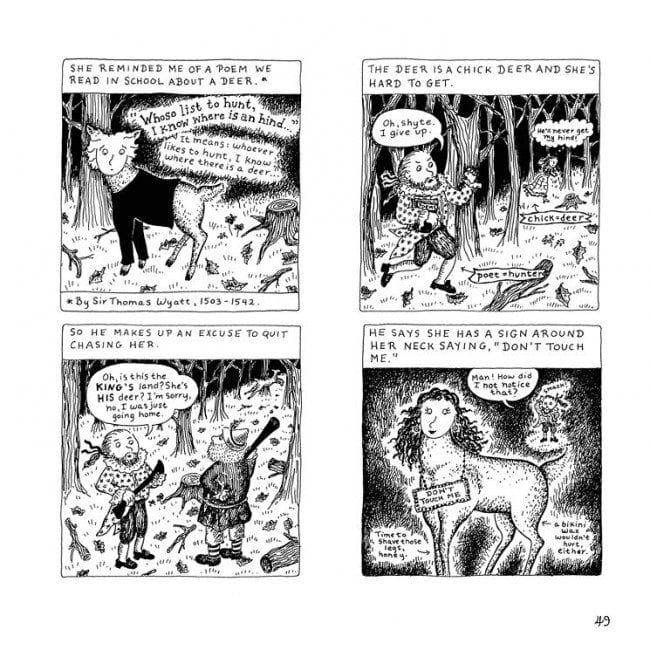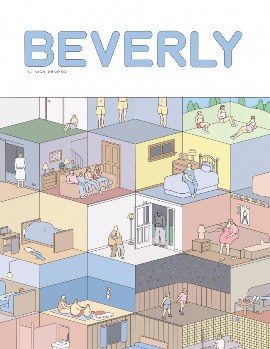Jennifer Hayden is a relative latecomer to comics, after years of work in graphic design and illustration. Like many converts, she took to comics with a zeal and work ethic that saw her very quickly get better in public. She's a rare success story: someone who enters into comics with an idea for a huge book who actually managed to finish it. That book, The Story Of My Tits, is a funny, bawdy and poignant memoir about body image, relationships, family and loss.
As a rule, I tend to detest cancer memoirs because they tend to be reductive in how they treat the narrative of the protagonist, usually showing them as victim or hero (or some combination thereof). The reality is that cancer, devastating as it is, is simply a disease. It doesn't alter character nor does it make a person's narrative instantly compelling. The reason why The Story Of My Tits works is that it's about much more than cancer; the hook of using her breasts as the book's focus may be gimmicky, but it's enormously effective. It's a gateway that allows her to tell her own story without seeming too pretentious or precious. Hayden has the rare ability to depict emotion without indulging in sentiment, which I think is due in part to her willingness to laugh at herself on nearly every page.
Indeed, Hayden can dish out punishment to others but never spares herself in an effort to get a laugh. The relationship drama of her time at college and the years of avoiding marriage with her now-husband might have been unbearable to write about at the time, but in this book, it's all fair game for emotional truths disguised as zingers. The design and format of the book is extremely conventional: four panels per page, with wide gutters. Hayden's illustration background is obvious in this regard; the book may as well have been one panel per page. There's little in the way of interesting panel-to-panel transitions or anything that provides a gestalt to each page other than the drawings themselves.
Fortunately, Hayden's scratchy style, which owes a lot to Julie Doucet, Roberta Gregory, and Aline Kominsky-Crumb, is more than up to the task of holding the reader's attention on a per-panel basis. What Hayden brings to the table on her own is her funny character design, complete with pointy noses and floppy hair. That almost bigfoot quality allowed her all sorts of leeway in bringing in funny background images that emphasize or mock aspects of the story. When a female roommate hits on her, she depicts intermingled female signs. These flourishes keep each panel lively, as they counterbalance a story that is otherwise really just a series of talking heads in a naturalistic setting. Hayden also adds variety on each page with dense hatching, stippling, spotting blacks and cilia-shaped lines that give each panel texture and depth. Considering that Hayden doesn't vary her line weights, that depth is crucial in giving the reader something to latch on to. It fills, and clutters, space, but in an agreeable way, as Hayden's eye is usually unerring on where to draw the line in this regard, and she never over-renders.
Hayden's voice has matured and evolved since her earliest work. Her first comics were bawdy in a way that was clearly intended to be slightly shocking, in a winking, off-putting, "know what I mean?" manner. In this book, by simply embracing that aspect of herself and naturally incorporating it on the page, her frankness regarding her own sexuality and her sarcastic nature regarding most of the world are funny and refreshing.
The book is a "how'd I get from point a to point b" story, in which she looks at her entire life and draws connections. What I love best about the book is that despite societal mores and social pressure, she is a person who learned to embrace her own sexuality and the idea that seeking her own pleasure was not a horrible thing that she needed to feel guilty about. That doesn't mean that there weren't awkward moments (each hilariously detailed), but there's a wonderful sense of freedom detailed on these pages, even as she struggled to find a purpose in life.

While the book purports to be about body image and disease (and to a degree, it is), the real theme of the book is the way in which our human connections keep us invested and focused. Indeed, the stories of Hayden as a college student and as a young adult do little to glorify hard living and hedonism. From her current perspective, Hayden depicts that as a fun time but also as an era where she was drifting as a person and felt unmoored. Her relationship with her future husband Jim was tenuous and even stressful, as there was uncertainty as to where it would all lead and even if either of them wanted it to lead someplace.

The drift was due in part to the disintegration of her parents' relationship, as her father was seeing another woman on a regular basis. What made things especially awkward is that they stayed married and living together for many years afterward, but Hayden's fury at her father and unwillingness to help her mother cope after a mastectomy has a profound influence on the proceedings in the rest of the book. Indeed, if that moment was a personal nadir because she chose to disconnect herself from her parents, then the rest of the book features Hayden slowly learning to trust, love, and grow.
There are some profoundly affecting scenes, as when she is pregnant and extends an olive branch to her father, who with a single gesture helps her understand that his feelings about her never changed. Her mother-in-law is a delightful powerhouse of a character, making her decline and eventual death especially poignant. More to the point, Hayden comes to understand that one's elders don't just teach one to live, they teach one how to die.
The final third of the book (over a hundred pages) is devoted to the discovery and treatment of her own breast cancer that resulted in a double mastectomy. The preceding 235 pages contextualize Hayden and her family for the reader. Without them, this would have been just another cancer memoir that's more about the disease than the person. Now, there are certainly slow spots in the book and areas where more material could have been cut in order to make the book sharper and more direct. However, Hayden's sense of humor makes her meandering pacing and tendency to tell instead of show simply parts of the ride. Indeed, it's almost like reading two different books: one written by Hayden the writer and one drawn by Hayden the artist, with each book related to each other but not truly integrated.
The cancer portion of the book pays off as one sees relationships years in the making tighten up and mature. In choosing to start to practice goddess worship, Hayden celebrates that sense of personal interconnection present among all people and things while surrendering the anxiety and need to control her environment that she had felt all along. By acknowledging death, Hayden celebrates the life she built with her husband and family. In the creation of this book, she also celebrated the true birth of herself as an artist.









